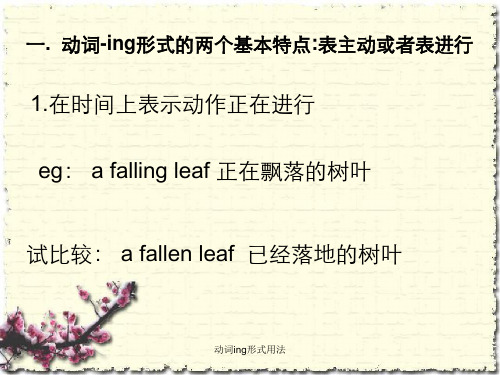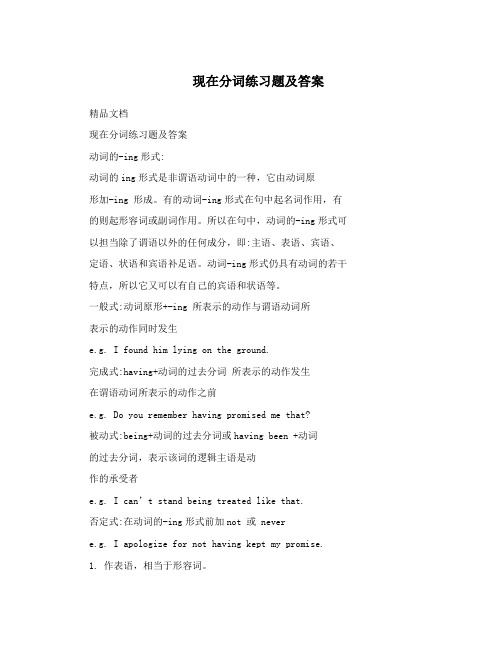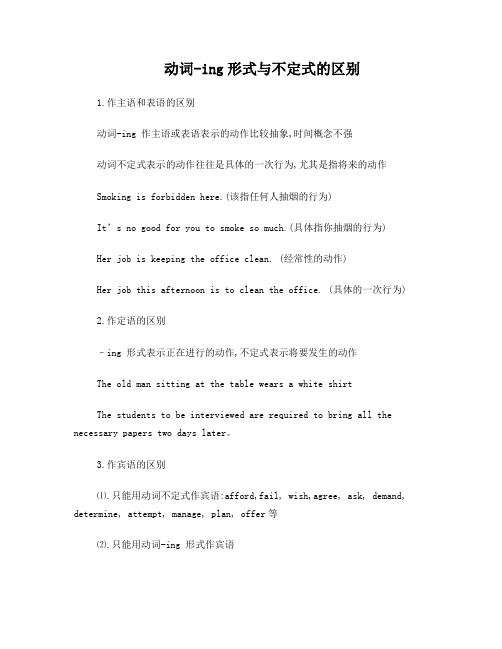动词的ing形式作表语,定语,宾补和状语
必修4动词-ing形式作表语、定语、宾语补足语和状语

年级高一学科英语版本人教实验版内容标题必修4 Unit 3 A taste of English humor动词-ing形式作表语、定语、宾语补足语和状语编稿老师林静【本讲教育信息】一. 教学内容:动词-ing形式作表语、定语、宾语补足语和状语二. 知识精讲(一)动词的ing形式作表语1. 动名词作表语一般表示抽象的、习惯性的行为,这时主语与表语的位置可以互换。
Her duty is taking care of the babies.照看婴儿是她的职责。
Our job is playing all kinds of music.我们的工作就是演奏各种音乐2. 现在分词作表语,表明的是主语的性质与特征,相当于形容词,可有比较级形式,亦可被very, quite,so等副词修饰,这时主语与表语的位置不可互换The music they are playing sounds exciting.他们演奏的音乐是如此令人兴奋The film we saw last night is quite moving.我们昨晚看的电影十分感人。
(二)动词的ing形式作定语1. 动名词作定语,表示该名词的用途或与其有关的动作,通常只能放在所修饰的名词前。
a walking stick手杖 reading room 阅览室 washing machine洗衣机2.现在分词作定语,说明所修饰的名词正在进行的动作或存在的状态,现在分词与所修饰的名词具有逻辑上的主谓关系,可换成定语从句来表达,单个的现在分词作定语常置于被修饰的名词前,现在分词短语作定语须置于被修饰的名词后。
Nobody can stop the running horse(=the horse that is running).没人能阻止那匹奔跑的马。
The student making the experiment(=who is making the experiment) is our monitor.正在做实验的那个学生是我们的班长。
动词ing形式用法(1)

⑸ 条件状语 :一般放在句首,其前可以加 if, unless等连词。
If playing all day, you will waste your valuable time. 如果玩一整天,你就会浪费了宝贵的时间。
动词ing形式用法
⑹ 让步状语 :一般放在句首,常常由 although / though /even if 等连词引导 。
动词ing形式用法
区分:
My mother is cooking.
主语 谓语
(cooking 是 cook 的现在分词,表示状态,在这表示妈妈正 在做饭这个状态)
My job is playing all kinds of instruments.
主语 系词
表语
(playing 是动名词,表示我工作的性质、属性,并不是现在 正在演奏乐器。)
forbid, keep, finish , admit 等。
eg. I enjoy learning about new things. 我喜欢了解新事物。 You should practise speaking English every morning. 你应该每天早晨练习英语。
动词ing形式用法
动词ing形式用法
2. 作宾语
⑴ 作介词的宾语
eg. She is interested in working for our firm. 她对为我们公司工作很感兴趣。
动词ing形式用法
⑵ 部分动词后必须用doing 作宾语,例如: enjoy, practise, advise, suggest, mind,
一. 动词-ing形式的两个基本特点:表主动或者表进行
1.在时间上表示动作正在进行 eg: a falling leaf 正在飘落的树叶 试比较: a fallen leaf 已经落地的树叶
现在分词练习题及答案

现在分词练习题及答案精品文档现在分词练习题及答案动词的-ing形式:动词的ing形式是非谓语动词中的一种,它由动词原形加-ing 形成。
有的动词-ing形式在句中起名词作用,有的则起形容词或副词作用。
所以在句中,动词的-ing形式可以担当除了谓语以外的任何成分,即:主语、表语、宾语、定语、状语和宾语补足语。
动词-ing形式仍具有动词的若干特点,所以它又可以有自己的宾语和状语等。
一般式:动词原形+-ing 所表示的动作与谓语动词所表示的动作同时发生e.g. I found him lying on the ground.完成式:having+动词的过去分词所表示的动作发生在谓语动词所表示的动作之前e.g. Do you remember having promised me that?被动式:being+动词的过去分词或having been +动词的过去分词,表示该词的逻辑主语是动作的承受者e.g. I can’t stand being treated like that.否定式:在动词的-ing形式前加not 或 nevere.g. I apologize for not having kept my promise.1. 作表语,相当于形容词。
1) The film is moving and interesting.1 / 24精品文档这部电影感人又有趣。
2) The news sounds encouraging.这个消息听起来激动人心。
pleasing, etc.)2. 作定语exciting news激动人心的消息a tiring day 累人的一天1) The man running over there is our chairman.=The man who is running over there is our chairman.这个跑过来的人是我们的主席。
2) The road joining the two villages is very wide.=The road that joins the two villages is very wide.连接两个村子的路非常的宽。
动词ing做宾补-表语-定语-状语及综合练习

动词ing做宾补-表语-定语-状语及综合练习2高中英语语法动词ing形式做宾补表语定语状语用法详解及练习第一部分:动词的-ing形式作宾语补足语1.动词的-ing形式可以在see, hear, notice, watch, feel, smell, look at, listen to, observe, find 等表示感官和心理状态的动词后面作宾语补足语,和一个名词或代词一起构成复合宾语。
We heard the children shouting upstairs. 我们听见孩子们在楼上叫喊。
I noticed a man running out of the bank when I got off the car. 我下车的时候注意到一个男人从银行里跑出来。
I felt my heart beating violently. 我觉得我的心在猛烈地跳动。
2.动词的-ing形式和不定式作宾语补语的区别在see, hear, feel, watch, notice等感官动词后,既可用动词的-ing形式构成复合宾语,也可用不定式构成复合宾语,两者之间有一定的区别。
用动词的-ing形式时,表示动作正在进行;用不定式时,表示动作发生了,即动作的全过程结束了。
He saw a girl getting on the car. 他看见一个女孩在上汽车。
(She was getting on the car.)He saw a girl get on the car and drive off. 他看见一个女孩上车开走了。
(She got on the car and drove off.)Do you hear someone knocking at the door 你听见有人在敲门吗?(Someone is knocking at the door.)Do you hear someone knock at the door 你听见有人敲门了吗?(Someone knocked at the door just now.)提示:如果宾语补足语是一系列的动作,通常只能用不定式来表示,不用动词的-ing形式。
最新Ving作表语定语宾补定语

3. -ing形式短语也可以用作非限制定语,
相当于一个非限制性定语从句,这时,它 与句子其他部分用逗号分开。如:
His brother, working as a teacher, lives in Beijing. = His brother, who is working as a teacher, lives in Beijing.
Ving作表语定语宾补定语
V-ing语法功 能
1.作表语 2.作定语 4.作宾语补足语
V-ing形式 作表语
-ing形式作表语时放在系动词之后,解释或说 明主语的内容,表示主语所具有的特征或属 性 Her hobby is painting. My job is looking after the children.
Smoking while having dinner is one of his bad habits.
注:不定式(to do)亦可作表语,但不定式侧重某次具体 的动作。
Her job is _n__u_r_s_i_n_g_ (nurse) patients in the hospital; but this weekend her task is __to__l_o_o_k__a_f_te_r__ (look after) her
注意:现在分词做宾语补足语表示动作与 谓语同时发生或正在进行,强调动作过 程
△ 在表示一个被动的动作时,如果这个动作是 现刻正在进行的,或是与谓语表示的动作同时 发生的,就可以用现在分词的被动形式。这种 形式可以作定语、状语或构成复合宾语
That building being repaired is our library. (定语)
动词-ing与不定式区别

动词-ing形式与不定式的区别1.作主语和表语的区别动词-ing 作主语或表语表示的动作比较抽象,时间概念不强动词不定式表示的动作往往是具体的一次行为,尤其是指将来的动作Smoking is forbidden here.(该指任何人抽烟的行为)It’s no good for you to smoke so much.(具体指你抽烟的行为)Her job is keeping the office clean. (经常性的动作)Her job this afternoon is to clean the office. (具体的一次行为)2.作定语的区别–ing 形式表示正在进行的动作,不定式表示将要发生的动作The old man sitting at the table wears a white shirtThe students to be interviewed are required to bring all the necessary papers two days later。
3.作宾语的区别⑴.只能用动词不定式作宾语:afford,fail, wish,agree, ask, demand, determine, attempt, manage, plan, offer等⑵.只能用动词-ing 形式作宾语admit.avoid.enjoy.finish.keep.miss.practise.suggest.allow.appreciate.consider.risk.mind 等⑶.即可用动词-ing形式也可用不定式作宾语a.意义相差不大(一)一些表示喜好或开始动作的动词,如:like,love,hate,prefer,intend,begin,start,continue等注:当begin和start使用进行时态时,后面常用不定式,另外动词understand,realize,see 在begin和start之后,也常用不定式She was beginning to get angry在like , love , hate , prefer 等词后,动词-ing 形式常表示某种习惯或爱好,而不定式多表示某个即将发生的具体行为。
分词ing型和ed型在英语中的用法及含义

分词ing型和ed型在英语中的用法及含义现在分词ing型具有动词的特征以及形容词或副词的功能,可以作表语、定语、状语或在复合结构中作宾补。
现在分词ing型具有主动意义。
而过去分词ed型说明主语情感心理上的感受,往往具有被动的意义。
1、现在分词ing型作表语:表示情感心理的及物动词的现在分词具有主动意义,表示主语的特征,能引起听话人情感心理上的反应。
例如:a. The situation is encouraging. 形势很使人鼓舞。
She is greatly encouraged. 她深受鼓舞。
b. The food smells inviting. 这个才真诱人。
I don’t feel invited to enter such an ugly building. 我没有欲望进这么难看的建筑。
最常这样用的分词有:amazing / amazed,astonishing / astonished,surprising / surprised,encouraging / encouraged,confusing / confused,disappointing / disappointed,exciting / excited,interesting / interested,puzzling / puzzled,shocking / shocked,worrying / worried,tiring / tired,satisfying / satisfied2、现在分词ing型作定语1)上述表示情感心理的及物动词的现在分词可以作前置定语,仍然表示它所修饰的名词的特征,能引起听话人情感心理上的反应。
它们与对应的过去分词作定语的区别同上。
He told us the disappointing news. 他告诉我们那令人失望的消息。
The amusing story set the amused audience laughed all the time. 令人捧腹的故事令感到好笑的观众大笑不止。
动词-ing

动名词的形式
主动形式
一般式 doing having done
被动形式
being done having been done
完成式
1.动名词一般式doing表示的动作通常是一般性动 作,即不是明确地发生在过去、现在或将来的动 作,或是与谓语动词所表示的动作同时发生的动 作。 例:Students sitting in this classroom are having an English contest.(主动,同时发生) The man planting trees in front of the building is our PE teacher.(主动,进行)
2.有些动词后既可跟 动名词 也可跟 不定式,意义 上没多大区别。如:like, dislike, love, prefer, start, begin, continue 等。 例: I don’t like watching TV.(指一般性行为) I like to play basketball tomorrow. (指一次的动作) 3.need,want,require,deserve+doing/to be done 主动形式表达被动意义。 例:The car needs repairing/to be repaired. 4.permit,allow,advise,forbid doing sth. sb. to do sth. 例:She doesn’t allow talking here. us to talk here.
例:He kept me waiting for an hour in the rain.
六、做状语
可充当时间、原因、条件、伴随、结果或让步 状语。逻辑主语为句子的主语,表主动,或者 进行。 例:When hearing the good news,the students were wild with joy.(时间状语) There being nothing to do, she went home.(原因状语)
- 1、下载文档前请自行甄别文档内容的完整性,平台不提供额外的编辑、内容补充、找答案等附加服务。
- 2、"仅部分预览"的文档,不可在线预览部分如存在完整性等问题,可反馈申请退款(可完整预览的文档不适用该条件!)。
- 3、如文档侵犯您的权益,请联系客服反馈,我们会尽快为您处理(人工客服工作时间:9:00-18:30)。
动词的ing形式作表语,定语,宾补与状语一、动词-ing形式作表语1、表示主语的内容,可以转换到句首作主语Her job is keeping the lecture hall as clean as possible、(= keeping the lecture hall as clean as possible is her job)她的工作就是尽量使报告厅保持干净。
2、表示主语具有的特征、性质与状态(动词ing 相当一个形容词)The problem is quite puzzling、这个问题很令困惑。
3、常用来作表语的现在分词有astonishing, amusing, confusing, disappointing, boring, encouraging, inspiring, moving, tiring, interesting, surprising等。
全析提示:动词-ing形式作表语时,其逻辑主语往往就是句子中的主语,但用作表语的-ing形式也可带有自己的逻辑主语。
What worries me most is her staying too late every night、(staying too late every night的逻辑主语就是her)二、动词-ing形式作定语1 单个的动词-ing形式可以作前置定语,一般具有两种含义。
①说明被修饰名词的用途与性能。
a reading room = a room which is used for reading 阅览室running shoes =shoes for running 跑鞋a working method =a method for working 工作方法②表示所修饰的人或物的动作或状态,在意思上接近一个定语从句,可以表示正在进行的动作,也可表示经常性动作或当时的状态。
developing countries = countries that are developing发展中国家an ordinary-looking house = a house that looks ordinary瞧起来很普通的房子a puzzling problem = a problem that puzzles somebody困扰人的问题2 作定语的动词-ing形式如就是一个短语,则应放在被修饰词的后面,做后置定语,相当于一个定语从句。
They lived in a house facing south、(=which is facing south)她们住在一所朝南的房子里。
Do you know the boy playing basket?(=Who is playing basket)您认识在打篮球的那个小男孩不?The man visiting Japan (=the man who is visiting Japan ) is my uncle正在访问日本的那个男人就是我的叔叔。
三、动词-ing形式作宾补1、动词-ing形式作宾语补足语常放在宾语后面,表示一个正在进行的主动性的动作,强调一个过程或一种状态。
When we returned, we found a stranger standing in front of the house、2、当主句转换为被动结构时, 原来作宾语补足语的动词-ing形式便转换为主语补足语。
They found the film very exciting、= The film is found very exciting、3、能用-ing形式作宾语补足语的几类动词:1) 表示感觉与心理状态的感官动词,(常见的有see, hear, feel, smell, find, notice, observe, look at, listen to等)+ sb + doing sth(作宾补)I felt somebody standing behind me、2) 表示指使意义的动词使役动词,(常见的有have, set, keep, get, catch, leave等)+sb/ sth + doing sth (作宾补)We kept the fire burning all night long、我们让火整夜燃烧着。
I won‘t have you running about in the room、我不允许您在房间里跑来跑去。
4、see, hear, feel, watch等动词之后用-ing形式与动词不定式作宾语补足语的区别:We heard the telephone ring、We heard the telephone ringing、前者表示动作正在进行,后者表示(或强调)动作的全过程。
四、动词-ing形式作状语动词-ing形式可以作状语,在句中表示时间、原因、结果、条件、让步、行为方式或伴随情况等。
动词-ing形式作时间、原因、条件、让步状语时多位于句首;作结果、伴随情况状语时常位于句末。
1 表示时间,相当于一个时间状语从句。
Having made full preparations, we are ready for the examination、我们已经作好了充分准备,现在可以应考了。
(= After we have made full preparations、、、)2 表示原因,相当于一个原因状语从句。
Being ill, he didn't go to school yesterday、由于生病,她昨天没有上学。
(= Since he was ill、、、)3 表示结果,相当于一个并列谓语。
His father died, leaving him a lot of money、= and left him a lot of money、她父亲死了,留给她许多钱、4 表示条件,相当于一个条件状语从句。
Working hard at your lessons, you will succeed、=If you work hard at your lessons、、、如果您努力学习,就一定能成功。
5 表示让步,相当于一个让步状语从句。
Knowing all this, they made me pay for the damage、= Although they knew all this、、、尽管知道了一切情况,她们还就是要我赔偿损失。
6 表示行为方式、伴随情况或补充说明,相当于一个并列结构。
He lay on the grass, staring at the sky for a long time、= 、、、and stared at the sky for a long time她躺在草地上,长时间地望着天空。
练习题1、Fill in the blanks with the correct form of verbs、1) _______(clean) women in big cities usually get paid by the hour、2) All of us watched the hunter ________ (bring) down the dangerous bear、3) When he woke up, he found himself ________ (lie) in hospital、4) Electricity lines were brought down by ___________ (fall) trees in the storm、5) The tall building _________ (build) now will be a hospital、6) The man ________ (wear) a sad look said, "I've lost my wallet、"7) —What is a water can used for?—It's used to _________ (water) flowers or something like that、8) There was a terrible noise __________ (follow) the sudden burst of light、9) The missing boy was last seen _________ (play) near the river、10) In parts of Asia you must not sit with your feet _______ (point) at another person、2、-ing形式作补语练与析从A、B、C、D四个选项中,选出可以填入空白处的最佳选项。
1、Though I have often heard this song ______, I have never heard you ______ it、A、being sung; sangB、sang; singingC、sung; singD、to be sung; to sing2、It was so cold that they kept the fire ______ all night、A、to burnB、burnC、burningD、burned3、He looked around and caught a man ______ his hand into the pocket of a passenger、A、putB、to be puttingC、to putD、putting4、—Did you meet anyone ______ at the party?—No, in fact, I found the party rather ______、A、interesting; boringB、interested; boringC、interesting; boredD、interested; bored5、The salesman scolded the girl caught ______ and let her off、A、to have stolenB、to be stealingC、to stealD、stealing6、Don’t leave the water_______ while you brush your teeth、A、runB、runningC、being runD、to run7、The _______ boy was last seen _______ near the East Lake、A、missing; playingB、missing; playC、missed; playedD、missed; to play8、A cook will be immediately fired if he is found _______ in the kitchen、A、smokeB、smokingC、to smokeD、smoked。
